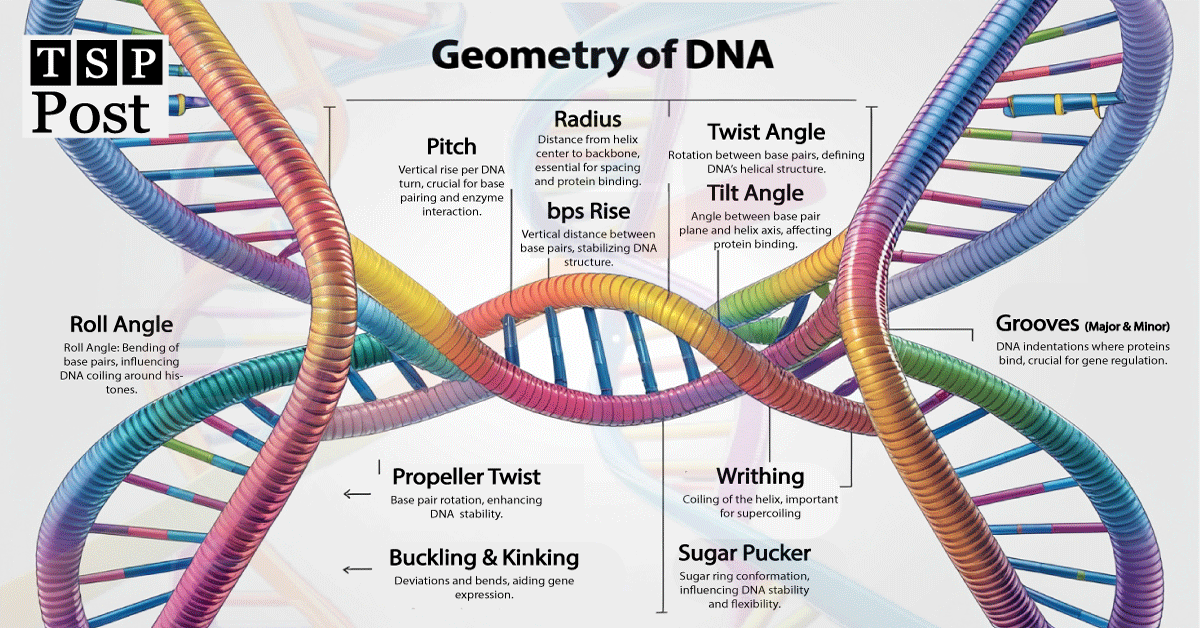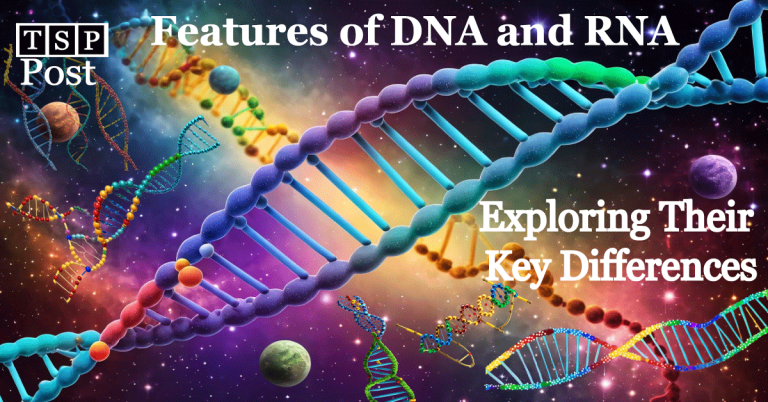DNA Geometry: Exploring the Shape and Function of DNA
Introduction
The geometry of DNA molecules is an interesting subject that lies at the intersection of physics, chemistry, biology, and mathematics. In particular, the DNA shapes and in particular, its double helix shape and more complex arrangements, are very critical for the replication, transcription, and the repair processes. Moreover, a fair claim in this article is made about the ways in which the form or structure of DNA dictates its biological activity by means of its geometric, structural and dynamical characteristics. To clarify these concepts, this post consists of three sections to understand DNA in a better way.
Geometric Parameters of DNA
The geometrical parameters largely defined the physical dimensions and angular periphery of DNA helices. These are not only important for stability of DNA but also for its function. For an explanation of different geometric parameters and examples that concern their definition of biological function, see this section.
Pitch
The pitch of a DNA helix refers to the vertical distance that it rises after one complete turn. For example, in B-DNA, this pitch is about 3.4 nanometers (nm) per turn. This space, 3.4 nm, is an accurate spacing which is highly critical for proper alignment of the base pairs. Furthermore, such spacing is very critical for DNA that interacts with a variety of proteins, especially during transcription and replication. Change the pitch, and the way in which DNA interacts with enzymes can be one that precludes proper or effective biological functions.
Radius
Radius is another important geometric parameter of DNA. Basically, the radius of the DNA helix is the distance from the center of the helix to the backbone. It is about one nm. This constant radius is very important for uniform spacing and for proteins to bind to the DNA strand properly during replication and gene expression (See Figure 1 (to be uploaded soon)).
Base Pair Rise
The rise between two consecutive base pairs refers to the small vertical distance, such as approx. 0.34 nm in case of B-DNA, that separates each pair along the DNA strand. This small rise is very important for base stacking, a critical interaction that stabilizes the double helix through van der Waals forces and keeps the DNA structure intact for proper functioning during cellular processes (See Figure 1 (to be uploaded soon)).
Twist Angle
The twist of DNA refers to the rotational angle between adjacent base pairs, which is approximately 36° in B-DNA. In other words, this precise angle is what gives DNA its characteristic right-handed helical structure. Variations in the twist angle can influence DNA supercoiling, a phenomenon that plays a crucial role during cellular stress and transcription, affecting the accessibility of genetic information (See Figure 1 (to be uploaded soon)).
Tilt Angle
The tilt of a DNA base pair is the angle formed between the plane of the base pair and the axis of the helix, usually ranging from 6° to 8° in B-DNA. This subtle inclination plays a critical role in shaping the major and minor grooves of the DNA helix, directly impacting how proteins recognize and bind to specific DNA sequences during processes like replication and transcription (See Figure 1 (to be uploaded soon)).
Roll Angle
Roll is another angle The bending of base pairs relative to the helix axis, about 4°–6° in B-DNA. For example, roll angle affects how tightly DNA can coil around histones, impacting chromatin structure (See Figure 1 (to be uploaded soon)).
Propeller Twist
The rotation between the bases of a pair, about 10°–20°. Propeller twists improve hydrogen bonding stability, enhancing the helix’s resilience to environmental stress (See Figure 1 (to be uploaded soon)).
Buckling and Kinking
Buckling refers to deviations from the ideal cylindrical shape, while kinking represents sharp bends in the helix. Kinkkings are often seen in DNA bound to transcription factors, aiding gene expression by exposing specific regions (See Figure 1 (to be uploaded soon)).
Writhing
It is the coiling of the DNA helix around itself. Writhing contributes to supercoiling, vital for DNA compaction in prokaryotic and eukaryotic cells (See Figure 1 (to be uploaded soon)).
Sugar Pucker
The conformation of the sugar ring in the nucleotides, which determines the geometry of the DNA backbone. Specifically, the two main types are the C-2′ endo (where the second carbon atom in the sugar ring is “puckered” out of the plane) and C-3′ endo (where the third carbon atom is puckered out). For example, in B-DNA, the sugar typically adopts a C-2′ endo conformation, which is essential for maintaining the helical structure. In A-DNA, a C-3′ endo conformation is more common, leading to a more compact structure. The sugar pucker influences the overall flexibility and stability of the DNA helix. It also impacts the specific interactions DNA can form with other molecules, such as proteins and drugs (See Figure 1 (to be uploaded soon)).
Table of Geometric Parameters of DNA
This table describes the Geometry of DNA, highlighting how parameters like pitch, roll angle, and propeller twist contribute to the stability, flexibility, and functionality of the double helix, ensuring precise protein interactions and gene regulation.
| Parameter | Definition | Example | Significance |
| Pitch | Vertical distance DNA rises after one full turn. | In B-DNA, approximately 3.4 nm per turn. | Impacts enzyme interaction during transcription and replication. |
| Radius | Distance from the center of the helix to its backbone, approx. 1 nm. | Uniform radius supports protein binding along DNA. | Maintains DNA structural stability. |
| Base Pair Rise | Distance between consecutive base pairs, approx. 0.34 nm. | Ensures efficient base stacking and stabilization via van der Waals interactions. | Stabilizes the DNA double helix. |
| Twist Angle | Rotation between adjacent base pairs, about 36° in B-DNA. | Forms a right-handed helix. | Affects DNA supercoiling during transcription and stress. |
| Tilt Angle | Angle between the plane of a base pair and the helix axis, approx. 6°–8° in B-DNA. | Influences major and minor groove geometry. | Affects protein binding and groove geometry. |
| Roll Angle | Bending of base pairs relative to the helix axis, approx. 4°–6° in B-DNA. | Influences DNA packaging around histones. | Affects chromatin structure and gene regulation. |
| Propeller Twist | Rotation between the bases of a pair, approx. 10°–20°. | Enhances hydrogen bonding stability, strengthening the helix. | Enhances the stability of the helix against environmental stress. |
| Buckling & Kinking | Deviation from ideal shape and sharp bends in the helix. | Seen in transcription factor-bound DNA, aiding gene expression. | Exposes specific DNA regions for gene regulation. |
| Writhing | Coiling of the DNA helix around itself. | Contributes to supercoiling for DNA compaction in cells. | Vital for DNA compaction and cellular organization. |
| Sugar Pucker | Conformation of the sugar ring in nucleotides, either C-2′ or C-3′ endo. | In B-DNA, typically adopts C-2′ endo, while in A-DNA, C-3′ endo is common. | Influences DNA flexibility and interaction with proteins and drugs. |
Structural Parameters of DNA
Structural parameters describe the DNA’s physical components and their arrangement.
Base Pairing
Hydrogen bonds are weak interactions that occur between specific nitrogenous bases in DNA, ensuring the double helix’s stability and uniform structure. For instance, Adenine (A) pairs with thymine (T) through two hydrogen bonds, while guanine (G) pairs with cytosine (C) through three hydrogen bonds. As a result, this difference in bonding makes G-C regions more stable compared to A-T regions due to the greater number of hydrogen bonds.
Sugar-Phosphate Backbone
Both strands of DNA consist of backbone. Specifically, sugar and phosphate parts of each strand involve in backbone formation. In detail, the backbone comprises alternating sugar (deoxyribose) and phosphate groups. However, mutations or chemical damage to the backbone can result in DNA strand breaks, affecting replication.
Minor Groove
The narrower groove of the helix, about 12 Å wide. Certain small-molecule drugs bind to the minor groove to inhibit cancer cell proliferation.
Major Groove
The wider groove, about 22 Å wide, where most DNA-binding proteins attach. Transcription factors bind to the major groove to recognize specific DNA sequences and regulate gene expression.
| Parameter | Definition | Example | Significance |
| Base Pairing | Hydrogen bonds between adenine (A) and thymine (T), guanine (G) and cytosine (C). | A-T pairs have two hydrogen bonds, G-C pairs have three bonds, making G-C regions more stable. | Impacts DNA stability and genetic integrity. |
| Sugar-Phosphate Backbone | Alternating sugar (deoxyribose) and phosphate groups. | Chemical damage to the backbone may cause strand breaks. | Essential for DNA stability and replication fidelity. |
| Minor Groove | Narrower groove, approx. 12 Å wide. | Small-molecule drugs bind to the minor groove to inhibit cancer cell growth. | A target for drug development. |
| Major Groove | Wider groove, approx. 22 Å wide, where most DNA-binding proteins attach. | Transcription factors bind to the major groove to regulate gene expression. | Crucial for protein recognition and gene regulation. |
Dynamic Parameters of DNA
Dynamic parameters describe the movement and flexibility of DNA, enabling its functionality during replication, transcription, and repair.
DNA Flexibility
DNA’s ability to bend and conform to its environment. Flexibility allows DNA to wrap around histones, forming nucleosomes essential for chromatin organization.
DNA Dynamics
The twisting, bending, and stretching movements of DNA. DNA helicase unwinds the helix during replication by exploiting these dynamics, exposing the strands for copying.
DNA Breathing
The transient opening of base pairs, facilitating nucleotide exchange. DNA breathing is crucial for mismatch repair mechanisms that maintain genetic fidelity.
| Parameter | Definition | Example | Significance |
| DNA Flexibility | Ability of DNA to bend and adapt to its environment. | Enables DNA to wrap around histones to form nucleosomes. | Crucial for chromatin structure and gene expression. |
| DNA Dynamics | Twisting, bending, and stretching movements of DNA. | DNA helicase unwinds the helix during replication. | Important for DNA replication and repair. |
| DNA Breathing | Transient opening of base pairs to facilitate nucleotide exchange. | DNA breathing aids in mismatch repair to ensure genetic fidelity. | Essential for DNA repair mechanisms. |
Conclusion
The intricate geometry, structure, and dynamics of DNA are integral to its function. In particular, from the tilt angles to the grooves and flexibility, every parameter contributes to DNA’s role in cellular processes. For example, the Geometry of DNA determines the helical structure, ensuring proper base stacking, stability, and interactions with essential proteins during replication and transcription. Moreover, variations in pitch, twist, and bending influence how transcription factors and enzymes recognise specific DNA sequences, highlighting the importance of the Geometry of DNA. Thus, understanding these aspects enhances our ability to manipulate DNA for applications in synthetic biology, genetic engineering, and medical research. Ultimately, the study of DNA geometry continues to unlock new frontiers in the biological sciences.







